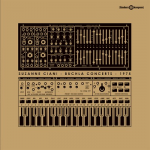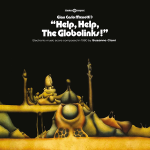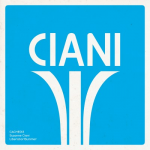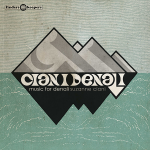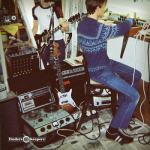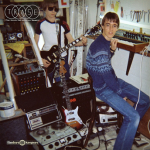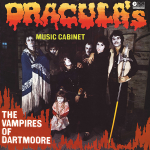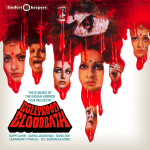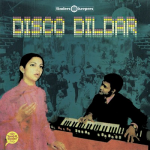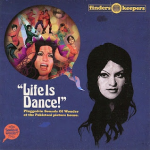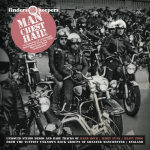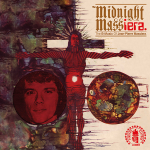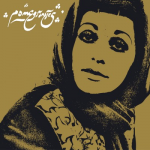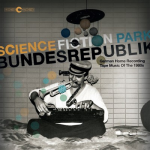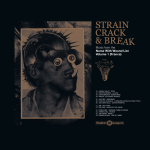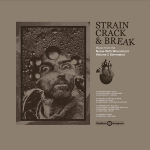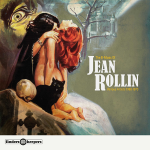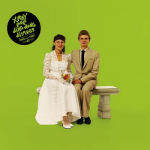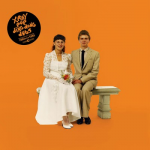Labels
Finders Keepers
- 01. Concert At WBAI Free Music Store
02. Concert At Phil Niblock’s LoftSUZANNE CIANI
Buchla concerts 1975
[engl] Finders Keepers invite you to witness the incredible first ever Buchla synthesiser concerts/demonstrations providing a distinctive feminine alternative to The Silver Apples Of The Moon if they had ever been presented in phonographic form. This is history in the remaking. This spring Finders Keepers Records are proud to release an archival project that not only redefines musical history but boasts genuine claim to the overused buzzwords such as pioneering, maverick, experimental, groundbreaking and esoteric, while questioning social politics and the evolution of music technology as we’ve come to understand it. To describe this records as a game-changer is an understatement. This record represents a musical revolution, a scientific benchmark and a trophy in the cabinet of counter culture creativity. This record is a triumphant yardstick in the synthesiser space race and the untold story of the first woman on the proverbial moon. While pondering the early accolades of this record it’s daunting to learn that this record was in fact not a record at all… It was a manifesto and a gateway to a new world, that somehow never quite opened. If the unfamiliar, modernistic, melodic, pulses, tones and harmonics found on this 1975 live presentation/grant application/educational demonstration had been placed in a phonographic context alongside the promoted work of Morton Subotnick, Walter Carlos or Tomita then the name Suzanne Ciani and her influence would have already radically changed the shape, sound and gender of our record collections. Hopefully there is still chance. In short, Suzanne was a self-imposed twenty-year-old employee of the Buchla modular synthesiser company, San Francisco’s neck and neck contender to New York’s Moog. Buchla was run by a community of festival freaks and academic acid eaters whose roots in new age lifestyles and the reinvention of art and music replaced the business acumen enjoyed by its likeminded East Coasters. In the eyes of the consumer the creative refusal to adopt rudimentary facets like a piano keyboard controller rendered the Buchla synthesiser the more obscure stubborn sister of the synth marathon, steering these incredible units away from the mainstream into the homes and studios of free music aficionados, art house composers and die-hard revolutionaries. Championed and semi-showcased by composer Morton Subotnick on his albums The Bull and Silver Apples Of The Moon, Buchla’s versatility began to open the minds of a new generation, but the high-end design features and no-compromise modus operandi was often confused with incompatibility and, in the pulsating shadow of Moog’s marketing, the revolution would not be televised nor patronised. Suzanne Ciani, as one of the very few female composers on the frontline (and also providing the back line) did not lose faith. These “concerts” are the epitome of rare music technology historic documents, performed by a real musician whose skills and academic education in classical composition already outweighed her male synthesiser contemporaries of twice her age. At the very start of her fragile career these recordings are nothing short of sacrificial ode to her mentor and machine, sonic pickets of the revolution and love letters to an absolutely genuine vision of and ‘alternative’ musical future. In denouncing her own precocious polymathmatic past in a bid to persuade the world to sing from a new hymn sheet, Suzanne Ciani created a bi-product of never before heard music that would render the pigeon holes “ambient” and “futuristic” utterly inadequate. Providing nothing short of an entirely different feminine take on the experimental “records” of Morton Subotnick and proving to a small, judgmental audience and jury the true versatility of one of the most radical and idiosyncratic musical instruments of the 20th century. These recordings have not been heard since then. The importance of these genuinely lost pieces of electronic musics puzzle almost eclipses the glaring detail of Suzanne’s gender as a distinct minority in an almost exclusively male dominated, faceless, coldly scientific landscape. Those familiar with Suzanne’s work, a vast vault of previously unpublished “non-records”, will already know how the creative politics in her art of “being” simultaneously reshaped the worlds of synth design, advertising and film composition before anyone had even dropped a stylus in her groove. Needless to say this record, finally commanding the archival format of choice, courtesy of the Ciani and Finders Keepers longstanding unison, was not the last “first” with which this hugely important composer would gift society, and the future of a wide range of exciting evolving creative disciplines. You have found a holy grail of electronic music and a female musical pioneer who was too proactive to take the trophies. With the light of Buchla and Ciani’s initial flame Finders Keepers continues to take a torch through the vaults of this lesser-celebrated music legacy shining a beam on these “non-records” that evaded the limelight for almost half a century. You can’t write history when you are too busy making it. With fresh ink in the bottomless well, let’s start at the beginning. Again. You, are invited!- Format
- LP
- Release-Datum
- 08.07.2016
- 01. Flowers Of Evil - Based On The Poem Élévation by Charles Baudelaire
02. Glass Houses
03. Token Spokes Part One
04. Token Spokes Part TwoSUZANNE CIANI
Flowers Of Evil
[engl] As a genuine vanguard of electronic music composition at the forefront of the modular synthesiser revolution in the late 1960s, Suzanne Ciani’s forward-thinking approach to new music would rarely look to the past for inspiration, which makes this unheard composition from 1969 a rare exception to the collective futurist vision of Ciani and synthesiser designer Don Buchla. In choosing to adapt the controversial prose of French poet Charles Baudelaire, Suzanne would join the ranks of ongoing generations of pioneering musicians like Olivier Messiaen, Karlheinz Stockhausen, Serge Gainsbourg, Etron Fou Leloublan, Celtic Frost and Marc Almond (not forgetting Star Trek’s William Shatner!), all equally inspired by the 19th century writer’s works of “modernité” (modernity), a self-coined term dedicated to capturing the fleeting, ephemeral experience of life in an urban metropolis, best exemplified in his symbolic, erotic and macabre ode to Parisian industrialisation, Les Fleurs du mal (Flowers Of Evil). In her varied career that would combine art gallery installations, major film soundtrackings and commissions for Atari, Suzanne Ciani’s earliest experiments remain some of her most challenging, beguiling and timeless… Flowers Of Evil ticks all the above boxes and flicks switches that would power-up a new uncharted universe of her own musical modernité. For the many enthusiasts that have already drawn the parallels between Baudelaire’s writings and experimental/ electronic music (a relationship rivalled only by the likes of J. G. Ballard and Aldous Huxley) some might instantly recognise an unconscious sistership between this recording and another 1969 electronic adaptation of Flowers Of Evil by celebrated female electronic composer Ruth White. An interesting distinction of White’s excellent version of Flowers Of Evil (released via Limelight records, home to the likes of Fifty Foot Hose and Paul Bley) is that its dark tone generation and vocal manipulation was created with a Moog synthesiser, the commercially triumphant rival to Suzanne and Don’s Buchla Systems (Buchla and Moog’s historic, simultaneous, neck-and-neck synth developments are well documented.) The fact that Ciani’s version was never intended for commercial release (not unlike her 1975 Buchla concerts, which could easily have taken Morton Subotnick’s Bull by the horns!) is also poetically reflective of the nature of Ciani and Buchla’s alternative perspective. The choice to present this extract from Flowers Of Evil in its intended French language further distances Ciani’s faithful reaction from some of its better-known variations. Having attempted to voice the poem herself, the multilingual Italian-American composer’s French accent did not meet her own standards, resulting in the request for a fellow unnamed French student who lived on campus at Mills College in Oakland to accurately verbalise the section of Baudelaire’s collection entitled Élévation.- Format
- LP
- Release-Datum
- 01.06.2019
SUZANNE CIANI
Help, Help, the Globolinks!
[engl] As faithful guardians of the Ciani Musica Inc. studio vault Finders Keepers Records twist the key and return to their collaborative series of previously unreleased music from one of the most important and influential composers in the history of multi-disciplinary electronic music. Open-minded, unpretentious, enigmatic and consistently inspiring, Suzanne Elizabeth Ciani would shatter the mould and invert the stereotype of electronic composers in the early 1970s with a bona fide education in classical music, a clear understanding of technology and a genuine will to communicate and naturalise electronic music. All of these unique attributes, coupled with her natural charm and generosity, would win her success and notoriety in the colliding worlds of art, film, advertising, theatre, dance and eventually popular recorded music in the latter part of the 21st century – a multifarious achievement which remained unrivalled by any of her contemporaries, regardless of gender, conquering many male-dominated platforms and breaking creative ground in the process. It is exactly these key factors that would form the basis for this multifaceted musical project that is stored within the grooves of the record you are now holding. This electronic soundtrack for an operatic, ecological, scholastic, science fiction theatre production for children of all ages not only further reveals Suzanne’s vibrant and versatile skills as an experimental musician and narrative sound designer but also highlights her European heritage – working to the script of Milanese librettist Gian Carlo Menotti and a cast of forward-thinking fellow Italian-American creatives (including Giorgio Armani and Fiorucci in the wardrobe department). Originally written and performed in 1968, and gaining worldwide acclaim throughout the 1970s, Gian Carlo Menotti would update and revise his play for the turn of the 80s which called for a new approach to the music and sound effects – all of which would make their world premier in New York high school theatres in April of 1980. “I was honoured to have been selected to create a new electronic score for Gian Carlo Menotti’s opera for children,” Suzanne told Finders Keepers. “The original production had been in 1968 and I felt that the electronic music component could be more playful and less abrasive than the original production.” For this task Suzanne would approach the brief with the same zeal and tenacity that she continues to apply to all her work by reinventing the process, challenging convention and supplying the audience with something they have never experienced before. For Help, Help The Globolinks Ciani would give Menotti’s well-travelled aliens a brand new voice and with reinvention she communicated with a young audience keen to hear the genuine sounds of the future while retaining melodicism and personality quite potentially overshadowing the “human” casts exceptional abilities and challenging the director’s and writer’s authority in true Ciani style: “I recall meeting with Maestro Menotti at his home in New York City,” recalls Suzanne. “Later I was told that he was upset by the size of my credit on the poster.” Unlike many successful electronic composers, Suzanne, as a serious and genuinely revolutionary artist, managed to evade the obvious typecasting of her music through the medium of shlock sci-fi cinema (Swiss composer Bruno Spoerri readily observes that all the best space film scores veered from this pairing) but within the realms of opera and education Suzanne found her perfect channel (scratching her other cosmic cinematic itches with android music in The Stepford Wives and as “the first female composer to score a major Hollywood movie” with The Incredible Shrinking Woman release one year after The Globolinks redux debut). Furnishing a plot of an ecological alien intervention worthy of a Magma youth starter pack and realigning early pioneering electronic operas such as Karl-Birger Blomdahl’s Aniara or Remi Gassman’s Electronics for family consumption, this virtually undocumented work by the hardest working woman in VCO business is finally preserved after just a handful of exclusive theatrical airings over 35 years ago. Having honed her craft in the close company of late synthesiser designer Don Buchla (a company of whose development she played a key role) it is plain to see how the young Suzanne Ciani combined roles as an abstract artist and an astute technician in equal measures, a rare duplicity which would be essential The Globolinks and all our musical quests for a brighter future.- Format
- LP
- Release-Datum
- 17.11.2017
- 01. Liberator
02. SummerSUZANNE CIANI
Liberator
[engl] For all your discotheque, roller rink and amusement arcade needs Finders Keepers Records in collaboration with synth pioneer Suzanne Ciani bring you the full version edit of her intergalactic vocoder driven TV jingle for Atari’s classic Liberator arcade game. Originally proposed for a possible promotional flexi-disc release this remastered feature length version includes a lost second verse and extra custom-made space age sound designs that hark back to her earlier work on Meco’s Star Wars Galactic Funk cash-in. Housed here in Atari style packaging and pressed on diamond white wax this 45 single comes complete with another Atari jingle Summer taken from her groundbreaking original company portfolio cassettes which were recently, errr, liberated from her original studio archives. This limited release also marks a brand new campaign of further unearthed computer music/synth funk artefacts from Finders Keepers latest trip into the Ciani Musica archive which will coincide with her first-ever Buchla fuelled tour of Europe penned for Autumn 2014.- Format
- 7''
- Release-Datum
- 30.07.2014
- EAN
- EAN 5060099505218
- 01. Lixiviation
02. Atari Video Games Logo
03. ‘Clean Room’ ITT TV Spot
04. Almay ‘Eclipse’ TV Spot
05. Paris 1971
06. Sound Of A Dream Kissing
07. Atari Corporate Tag
08. Princess With Orange Feet
09. ‘Pop & Pour’ Coca-Cola Logo
10. ‘Discover Magazine’ TV Spot
11. Live Buchla Concert 1975
12. ‘Inside Story’ PBS TV Spot
13. ‘Liberator’ Atari TV SPot
14. Eighth Wave
15. Sound Of Wetness
16. Second BreathSUZANNE CIANI
Lixiviation
[engl] The American Delia Derbyshire Of The Atari Generation With a sonic portfolio that boasts commissions for the Xenon classic pinball machine, the sounds for the Meco Star Wars theme, the Atari TV commercials and the elec- tronic sound effects in the original Stepford Wives film (amongst many others) the mutant electronic music CV of Suzanne Ciani is proof that in a 1970s commercial world of boys toys, monopolised by a male dominated media industry, a woman’s touch was the essential secret ingredient to successful sonic seduction. A classically trained musician with an MA in music composition this American Italian pianist was first introduced to the synthesizer via her connections in the art world when abstract Sculptor and collaborator Harold Paris introduced Suzanne to synthesizer designer Don Buchla who created the instrument that would come to define Ciani's synthetic sound (The Buchla Synthesiser). Cutting her teeth providing self-initiated electronic music projects for art galleries, experimental film directors, pop record producers and proto-video nasties Suzanne soon located to New York where she quickly became the first point of call for electronic music services in both the underground experimental fields and the commercial advertising worlds alike. Counting names like Vangelis and Harald Bode amongst her close friends Suzanne and her Ciani Musica companybecame the test- ing ground for virtually any type of new developments in electronic and computerized music amassing an expansive vault of commercially unexposed electronic experi- ments which have remained untouched for over 30 years... until now. Finders Keepers Records are happy to announce a new creative archive based rela- tionship with Suzanne Ciani, a very unique and celebrated experimental composer in her own right, who, as one of the very few female composers in the field (Save Chicago's Laurie Spiegel, Italy's Doris Norton, and a post-op Walter Wendy Carlos) turned a hugely significant wheel behind-the-screens of many early computerised music modules throughout the 1980s dating back to her formative years studying at Stanford's Artificial Intelligence Labs in the early 70s. Suzanne Ciani's detailed and academic approach to music and electronics coupled with an impeccable sense of timing and melody (and a good sense of humour) shines throughout this new collec- tion of previously unreleased recordings. Lixiviation complies and recontextualises both secret music and commercial experiments of Suzanne Ciani made for micro- cosmic time slots and never previously documented on vinyl or CD. This is the first sneak peek of the early Ciani metal music and non-pop that later went on see her nominated for multiple Grammy awards for her later achievements which brought synthesiser music to the new age movement.- Format
- LP
- Release-Datum
- 13.02.2012
- EAN
- EAN 5060099503665
- 01. Denali
02. Fresh Snow
03. Windy Corner
04. Slow Climbing
05. The Last Rest
06. Getting To The Top
07. Downhill At LastSUZANNE CIANI
Music for Denali
[engl] Finders Keepers Records’ continued and unwaning commitment to preserving the archives of composer Suzanne Ciani pays off in an avalanche of dividends with this latest master tape discovery, placing further markers in the historical development of electronic music and cinematic composition. Developed at a lesser-documented axis combining Ciani’s key disciplines as a revolutionary synthesist and an accomplished pianist, these early works from 1973 capture a rare glimpse of one of the world’s most important electronic music figures embarking on the early throes of a fruitful career as a film composer and sound designer with this rare and previously unheard documentary music illustrating the first-ever skiers’ decent from the peak of the tallest mountain in Alaska. Capturing innocence and optimism in its composition, but never less than masterful in its realisation, Denali takes what would later become the yin and yang in Ciani’s versatile musical personality and provides unrivalled vistas from both side of the mountain, scaling a treacherous and fine creative line. Within the context of Suzanne Ciani’s achievements the words “maverick” and “pioneer” have regularly shared sentences amongst a list of “firsts” when documenting her expansive CV as a Grammy nominated, million-selling recording artist, and genuine revolutionary in the progression of future music in all its early capacities. But it is with this important release of uncovered recordings from early 1973 that Ciani’s “exploratory” compositions from her formative years find kinship alongside the exploits of other radical and historic trailblazers, as the music for the film known only as Denali finally achieves a wider vantage point. Commissioned in the early years of Suzanne’s “professional” life, in a period that bridged her activities with art installations, experimental theatre and her rising reputation as a film composer and sound designer, the Denali tape reels preceed Suzanne’s film work such as Lloyd Michael Williams Rainbow’s Children (1975) and Bryan Forbe’s The Stepford Wives (1975) by just 18 months, and capture Suzanne at her wide-eyed best two years after scoring her first-ever paid work providing synthesiser loops for aquariums in Middle America shopping malls (Fish Music, FKSP011). It was in 1972, whilst occupying a studio space in San Francisco, as one of a small group of prophets then celebrating the interpolation of Don Buchla’s electronic instruments, that Suzanne was approached by a French speaking ski enthusiast and short film producer called Patrick Derouin to create “forward-thinking” and “otherworldly” themes and sound design for some amazing unseen footage of the first-ever people to ski down the death-defying face of Mount Mckinley in Alaska. Recognised as one of the tallest mountains in the world, this footage would mark a significant historic feat previously inconceivable outside the hat stand notions of a small group of French speaking European explorers and would also coincide with cultural pressure within the Alaska state legislature to lobby for the United States Board On Geographic Names to reinstate the mountain’s traditional name Denali (a decision widely supported by The Koyukon Athabaskans who inhabit the area around the mountain for centuries). Given what is now widely recognised about Suzanne Ciani as a composer, it is plain to see that Derouin came to the correct place and as you will hear, for the first time, within the grooves of this record the collective aura of challenge and enlightenment is almost breathtaking in its precise narrative ability; striking similarities with Eno, Kraftwerk and Neu! at their melodic best but from a very different vantage point, with polar opposite means of execution, whilst operating on Ciani’s unique and all-important feminine “wave” length. The music on this record was also commissioned two years before Suzanne’s first Buchla concerts in 1974 and 1975, which were accompanied by her seminal National Endowment Paper, and would reveal Suzanne’s proud commitment to the developed Buchla instrument and her confidence in its place in modern music, thus proving the likes of Denali to be an earlier showcase of the instrument in it’s advanced infancy although still robust enough to carry the emotive and ambitious songwriting skills of the classically trained Ciani. After hearing this record it will come as little surprise that the track known as Ski Song would later be reappropriated (and rerecorded) on Ciani’s globally critically acclaimed debut album Seven Waves (as the Fourth Wave), which was initially released exclusively in Japan before Turkish-born electronic music pioneer _lhan Mimaro_lu signed the record to his Finnidar imprint at Atlantic records, thus making musical history for Suzanne as a widely celebrated American-Italian female composer. It stands as testimony to the composer’s determination and inventive nature that this single track, which would later make its way on to every future music best-seller list in the country, was originally composed on just piano and the modular synth model which she had helped to assemble on Buchla’s production line ten years before her Tokyo debut. “Denali was composed using just Buchla and piano,” explains Suzanne in 2020. “It was recorded at Rainbow Recording, which is the studio I found and shared with recording engineer Richard Beggs, who then sold it to Francis Ford Coppola after I fell in love and quickly moved to LA,” she laments. “If I had stuck around I would have probably ended up doing sound for Coppola,” she jokes. Instead, Suzanne would in a short time find her filmic feet in Hollywood (providing sound design for Michael Small’s aforementioned The Stepford Wives soundtrack) which would later lead to her winning the accolade of first female film composer to single-handedly record a major motion picture with The Incredible Shrinking Woman in 1982. But it was ten years earlier with Denali that the ball had started rolling alongside the film reel sprockets at Rainbow Recordings. “I have very fond memories of first meeting Patrick and his thick French accent,” Suzanne explained. “He was a rugged looking young man who literally looked like he had just stepped down from the mountain himself.” The basic brief around Suzanne’s musical journey was to be “The story of the arduous ascent and joyous descent of the mountain,” which, with one of her most melodic and dynamic projects from her early years, she successfully illustrated with utmost aplomb. Although Suzanne would only see the short film a handful of times, mostly during intense late night recording sessions (“I used to dress like a sailor so I wouldn’t get street hassle on the way home”), and never meet to actual cast of the film, she can still remember mind-blowing shots of the skier cascading down the mountains, images that have remained with her throughout the subsequent five decades as a composer. As mountaineering history denotes the first-ever skier to descend from the tip of Denali was indeed in 1972, in dates that correlate directly to Suzanne’s meticulously kept tape library and studio diaries. The explorer’s name was French speaking Swiss skier Sylvain Saudan, a celebrated household name amongst enthusiasts to this day. Like Suzanne, like Saudan, neither artist have diverted from their path, turned their back on a challenge, nor lost their footing in the face of adversity.- Format
- LP
- Release-Datum
- 14.08.2020
- EAN
- EAN 5060099507427
- 01. Electronic Rock (1983 Instrumental Version)
02. Electronic Rock (Original 1981 LP Version)T.R.A.S.E
Electronic Rock
[engl] Known amongst a small group of teenage friends as T.R.A.S.E. (Tape Recorder And Synthesiser Ensemble) this previously unearthed and fully formed electronic music project was spearheaded by a 16-year-old school- boy as an extension of his woodwork, metalwork and science classes in 1981. Composed and recorded using a self-made synth, audio mixer and elec- tronic percussion units T.R.A.S.E would bridge the gap between a love for sci-fi horror soundtracks, Gary Numan b-sides and an extra curricular hobby as a sound and lighting designer for school plays - bequeathing a backstory as unique and unfathomable as the individualistic sonic results that he would finally commit to C90. Having successfully recorded his only solo album, Electronic Rock (which was never duplicated beyond his own demo copy), this early musical achievement by Andy Popplewell stands up as a rare self-initiated example of embryonic experimental electro pop and genuine outsider music, marking the early domestication of synthesisers and the dawn of electronic home recording studios and the uninhibited results. Unhindered by adult concepts like self-consciousness, popular snobbery, fashion, pride and fear of failure (while funded by paper rounds and odd jobs in his Mancunian community), Andy, armed with the plans to the Chorosynth kit module, an old junk shop piano keyboard and some hand-me-down tools from his recently deceased dad, would fill an exercise book with plans, arrangements and self-penned new wave pop lyrics to fully realise the potential of his one-man synthetic symphony. Reaping the benefits of his own stencilled circuit boards and soldering iron skills (whilst occasionally enlisting the part time help of his younger brother on guitar) T.R.A.S.E’s homemade technology pop continued to bloom right up until the very cusp of adolescence when careers officers and real life responsi- bilities saw the end of Andy's reel to reel multitracking which is finally pre- sented here for the first time since it was sung and played. This ambitious cross section of robotic funk and moody soundscape sequences makes instrumental nods to John Carpenter and Kraftwerk next to unpolished vocal drones worthy of a sedated Human League or Joy Divison, all of whom shared radio dial digits amongst Giorgio Moroder, Tubeway Army and The Glitter Band as Popplewell’s clearest unabashed influences. The T.R.A.S.E tapes, finally unearthed by Finders Keepers, show the full extent of the projects repertoire before the "group's" final hiatus which, for Andy, was followed by a working education in London under BBC employ- ment as a trainee radio engineer (not far from the closed door of the Radiophonic Workshop) which has since led to a widespread reputation as one of the country’s leading independent tape engineers/editors/archivists indiscriminately splicing and baking vintage tapes for anyone in-between Alpha in Brussels and ZTT in London. Having worked with hundreds of reputable studios, pop stars and media companies throughout his career Andy claims he has rarely been asked about his own musical history in 30 working years, Finders Keepers are glad we Popped that very question.- Format
- 7''
- Release-Datum
- 27.10.2013
- EAN
- EAN 5060099504686
- 01. T.R.A.S.E. Sketch-1
02. Electronic Rock (1983 instrumental version) 03. Harmonium
04. T.R.A.S.E. Sketch-3
05. Talk To Me (1983 version)
06. T.R.A.S.E. Sketch-4
07. Angel Face
08. Unrequited Love (1983 instrumental version) 09. T.R.A.S.E. Sketch-5
10. This Life Of Yours (1981 version)
11. We Are So Fragile
12. Momento (1983 electric guitar version)
13. Twilight
14. War Machine
15. VoiceT.R.A.S.E
Tape Recorder And Synthesiser Ensemble
[engl] Known amongst a small group of teenage friends as T.R.A.S.E. (Tape Recorder And Synthesiser Ensemble) this previously unearthed and fully formed electronic music project was spearheaded by a 16-year-old schoolboy as an extension of his woodwork, metalwork and science classes in 1981. Composed and recorded using a self-made synth, audio mixer and electronic per- cussion units T.R.A.S.E would bridge the gap between a love for sci-fi horror sound- tracks, Gary Numan b-sides and an extra curricular hobby as a sound and lighting designer for school plays - bequeathing a backstory as unique and unfathomable as the individualistic sonic results that he would finally commit to C90. Having suc- cessfully recorded his only solo album, Electronic Rock (which was never duplicat- ed beyond his own demo copy), this early musical achievement by Andy Popplewell stands up as a rare self-initiated example of embryonic experimental electro pop and genuine outsider music, marking the early domestication of synthesisers and the dawn of electronic home recording studios and the uninhibited results. Unhindered by adult concepts like self-consciousness, popular snobbery, fashion, pride and fear of failure (while funded by paper rounds and odd jobs in his Mancunian community), Andy, armed with the plans to the Chorosynth kit module, an old junk shop piano keyboard and some hand-me-down tools from his recently deceased dad, would fill an exercise book with plans, arrangements and self- penned new wave pop lyrics to fully realise the potential of his one-man synthetic symphony. Reaping the benefits of his own stencilled circuit boards and soldering iron skills (whilst occasionally enlisting the part time help of his younger brother on guitar) T.R.A.S.E’s homemade technology pop continued to bloom right up until the very cusp of adolescence when careers officers and real life responsibilities saw the end of Andy's reel to reel multitracking which is finally presented here for the first time since it was sung and played. This ambitious cross section of robotic funk and moody soundscape sequences makes instrumental nods to John Carpenter and Kraftwerk next to unpolished vocal drones worthy of a sedated Human League or Joy Divison, all of whom shared radio dial digits amongst Giorgio Moroder, Tubeway Army and The Glitter Band as Popplewell’s clearest unabashed influ- ences. The T.R.A.S.E tapes, finally unearthed by Finders Keepers, show the full extent of the projects repertoire before the "group's" final hiatus which, for Andy, was fol- lowed by a working education in London under BBC employment as a trainee radio engineer (not far from the closed door of the Radiophonic Workshop) which has since led to a widespread reputation as one of the country’s leading independent tape engineers/editors/archivists indiscriminately splicing and baking vintage tapes for anyone in-between Alpha in Brussels and ZTT in London. Having worked with hundreds of reputable studios, pop stars and media companies throughout his career Andy claims he has rarely been asked about his own musical history in 30 working years, Finders Keepers are glad we Popped that very question.- Format
- DoLP
- Release-Datum
- 14.10.2012
- EAN
- EAN 5060099504631
- 01. Die Folterkammer Des Dr. Sex (The Torture Chamber Of Dr. Sex)
02. Crime And Horror
03. Der Feuerdrachen Von Hongkong (The Fire-Dragon Of Hongkong)
04. Mord Im Ohio Express (Murder In The Ohio Express)
05. Tanz Der Vampire (Dance Of The Vampires)
06. Hallo, Mister Hitchcock
07. Der Henker Von Dartmoore (The Executioner Of Dartmoore)
08. Ende Eines Killers (Killer's End)
09. Die Wasserleiche (The Soaked Body)
10. Eine Handvoll Nitro (A Handful Of Nitro)
11. Dr. Caligaris Gruselkabinett (Dr. Caligaris Creeps-Cabinet)
12. Frankenstein Grüst Alpha 7 (Frankenstein Greets Alpha 7)THE VAMPIRES OF DARTMOORE
Dracula's Music Cabinet
[engl] Finders Keepers presents this uber-rare soundtrack to a film that never existed, performed by an imaginery pop group. Incredible Polanski inspired German hip hop psychsploitation beats from 1968. You couldn’t script it… You are nineteen minutes and twenty-two seconds in to your peak- season cruise around the Kraut-schlock peripheries. To say the trip has been an eventful one would be an understatement – you don’t know what to expect next and your 12” x 12” Germanic tour guide has proved quite unreliable thus far. As your diamond tipped vessel maneuvers through the grooves of your ninth horrific attraction (entitled The Soaked Body) the soundtrack awkwardly becomes background music and you are overcome with the sound of gushing water… ‘Help!’ you think sarcastically, the music, or is that muzak, is drowning! This is the movie soundtrack to a film that never existed. This is the movie soundtrack by the band that was never requested. These were the sound library musicians who had to invent their own clients and imaginary cast, crew and plot to get their music heard, by a niche audience, before floating deep into the depths of the rare record reservoir gasping for breath. To take a cinematic cue the record in question is the eurotrash pop equivalent of Jean Renoir’s tragic/triumphant Boudu character who as a homeless, confused and desolate down-and- out plunged to the depths to be unwillingly rescued, resuscitated then after gradually winning the hearts of an entire family becomes respected and revered as royalty. Over twenty years after the mad scientists, Dr. Horst and Ackermann, first breathed life into this short-lived beast, brave and intrepid vinyl explorers have sporadically returned to the doors of Dracula’s Music Cabinet to resurrect the sonic spooks and mutated melodies to share with nerds, mods, rockers, hip hoppers, psych nuts and Krautsiders alike. The lifeless corpses of The Vampires Of Dartmoore that lay six feet beneath the belly of the Eins Deutschmark bins has since crept through the record collections of the aforementioned social circles devouring continental currencies and demanding random ransoms of €250 plus, not to mention sweat, tears (of laughter) and a lot of blood.- Format
- LP
- Release-Datum
- 01.04.2022
- EAN
- EAN 5060098507793
- 01. Fusioon - Tocata Y Fug
02. Furia - Furia
03. Los Roller - Un Consejo
04. Huracanes - Cambio
05. Sonya - En Mi Nube (Get Off My Cloud)
06. Rudy Ventura - Soy Un Sonador
07. Fusioon - Ciclos
08. Fuerza - Un Lugar
09. Rudy Ventura - Yamasuki
10. Control - Por Las Viejas Calles
11. Fusioon - Farsa Del Buen Vivir
12. Los Huracanes - Good Gally Miss Molly
13. The Brisk - El Juego Del Amor
14. Los Ros - Cuentame Cosas Tuyas
15. Albert Band - Ella Tiene El Cabello Rubio
16. Los Mismos - Jefe Ironside
17. Los Roller - Camino Cortado
18. Soledad Miranda - La Verdad
19. Los Gritos - Veo Visions
20. Alfonso Santisteban - Zorongo
21. Top Show - Escucha Nina
22. Hermanos Calatrava - Space OddityV/A
ABSOLUTE BELTER
[engl] In the realms of music business the overused term indie has become somewhat convoluted within the last three decades. Bandied around as a stylistic statement, an ethos or a genre in its own right there are very few successful popular music labels that can truly claim to be independent of those major corporations that in time plan to dominate the entire recorded output of the global music community. Here at Finders Keepers these seldom-championed self-sufficient industries have always been truly inspirational sources. Labels such as Kuckuck in Germany, BYG in France and Sain in Wales have all maintained utmost artistic integrity and broke truly experimental and successful careers without having to surrender their creative loins to the ravenous bottomless stomach of the major music industry and for this reason the music flies freely amongst us adding new life after life to musical misfits as free music lives, breathes and procreates. By the start of the new millennium the revival of the vinyl record buying market had reached a level that turned second hand shops and auction websites into train spotters sports arenas. The competitive nature of record digging, trading, sampling and DJing took misplaced-pop aficionados out of their comfort zones in search of black 12" and 7” medals that might outsmart their fellow collectors or tantalize the fresh ears of a well adjusted freak-fuelled audience. Throughout the 1990s the rise in popularity of indigenous European genres such as Krautrock and French Ye-Ye saw American, English and Japanese collectors re-invent the concept of world music pondering un-raked territories... Europe, of course, would provide the central co-ordinates to start the global trophy treasure hunt. The neatly arranged and numbered racks of laminated 7 inch sleeves that originated from Barcelona in the 60s and 70s have provided many of these vinyl vultures and portable record deck wielders with enough random and varied music to justify week long pop-pilgrimages to Spanish flea markets and thrift shops. Belter records, with their familiar yellow graphic bands and blue/silver or brown/yellow labels punctuate racks of other Spanish delights in a country whose habitual record buying market was initiated and facilitated by a self-made home grown institution. This is were you'll find hip-hop producers rubbing shoulders with mods and proggers, shying away from the sun, contemplating a supposedly-authentic paella supper and repeatedly flipping over the endless rivers of 7" circles and squares in search of another Absolute Belter. The year 2010 marks the 50th anniversary of one of the most recognised independent commercial music companies of post-war Europe and with a back catalogue of magnetic tape that could circle the planet the legacy of Barcelona’s Belter repertoire has touched each continent, proudly defiant in the face of fascism, technology, revolution, capitalism, patriotism, bad fashion, good vibrations and dubious humour. Viva la musica!- Format
- DoLP
- Release-Datum
- 12.04.2010
- EAN
- EAN 5060099502163
- 01. Rajesh Roshan - Sannata Theme
02. Hemant Bhosle - Sansani Khez Koi Baat
03. Bappi Lahiri - He Met Me In The Guest House
04. Bappi Lahiri - Meri Jaan
05. Laxmikant-Pyarelal - Aa Jaane Jaan
06. Ratandeep Hemraj - Birha Ki Maari Koi
07. Bappi Lahiri - Dance Music
08. Sapan Jagmohan - Aji Kahan Gum Ho
09. Laxmikant-Pyarelal - Theme Music
10. Usha Kanna - Tere Jaisa Pyara Koi Nahin
11. Rajesh Roshan - Marjaban Too Kuthe Part 1
12. Sapan Jagmohan - Sote Sote Adhi Rat
13. Hemant Bhosle - Theme Music
14. Sapan Jagmohan - Main Theme
15. Bappi Lahiri - Disco Title Music
16. Rajesh Roshan - Superman, Superman
17. Khemchand Prakash - Dance Music
18. Bappi Lahiri - Aafat
19. Laxmikant-Pyarelal - Chalo Re Doli
20. Rajesh Roshan - Marjaban Too Kuthe Part 2
21. Nadeem & Shravan - Dekho Dekho Dekho Magar Pyar Se
22. R. D. Burman - Bindya Tarse Kajra BarseV/A
Bollywood Bloodbath
[engl] After what seems like a thousand years of blood, sweat, tears, and a lot more blood, your zombified disc disciples at Finders Kreepers unveil one of their most exquisite, exhumed, ectoplasmic, and existentially essential collections yet. This musical mausoleum of malformed freak funk and dreadful discothèque pop has been resurrected from the maligned cinematic subculture of Bombay’s bloodthirsty horror film industry and witnesses the cognoscenti of the Bollywood pop scene at their most creative, destructive and experimentally effective. Bollywood Bloodbath features India’s finest composers, such as Bappi Lahiri, R.D Burman, Sonik Omi, Sapan Jogmohan and Laxmikant Pyarelal making the kind of radical risk-rock that would under normal circumstances have studio security escorting these overworked maestros off set for a well-earned break or a relaxing exorcism. Take all the most oblique, indigenous characteristics of your favourite Bollywood musicals then condense them into a bubbling serum and watch the Jekyll and Hyde transformation commence as these A-list composers create bloodcurdling B-Music for the films they never thought the outernationals would see or hear. You’ve heard Italy’s most famous composers when they soundtrack unwatchable Roman slasher flicks with on their own uncompromised and underpaid terms? Well that blueprint just turned blood red with sub-shoestring, low-budget studio wizards gambling with rigamortis rock, disjointed disco and low-voltage electronics for seldom screened scenes of desi Draculas, lycanthropic lady killers and psyched-up swamp monsters. Ever wondered what the DJ would play in a 1981 luxury hotel that was built on an ancient Christian cemetery? No? Well it sounds like someone just got possessed by Jimmy Page and Nile Rogers at the same time. Help! But séance fiction aside the factual history of the untravelled Bollywood horror phenomena is fully re-exhumed with this compendium in true faithful Finders Keepers style. Carefully documenting the drummy theme from the first-ever 1949 Indian ghost film this benchmark collection follows the sinister lineage as directors of bloody thrillers take chances on shuddering synopsis and haywire sonic special effects. Leading up to the inauguration of the notorious Ramsay Bros film company (whose sibling revelry in the 70s and 80s lead to the inclusion of flight-style puke bags in participating picture houses) this compilation pulls no punches and plunges the ‘B’ of Bombay into the heart of the b-movie and squirts a masala of bloody ketchup and red wine onto the sets of Bollywood’s glorious filmic musicals. Licensed exclusively from the independent Indian film music companies (revealing incidental tracks that they didn’t even know they owned) Bollywood Bloodbath is the result of avid stomach turning research via VHS tapes, chewed-up cassettes, and LPs, 12”s and 45s remastered from some of the only existing master tapes; presented on both CD and vinyl for both the hairy home listeners and daring DJs just in time for the witching season. Hunt down the spooky Sansani before it gets to you first!- Format
- DoLP
- Release-Datum
- 27.10.2011
- EAN
- EAN 5060099503313
- 01. Sedmikrasky
02. Peach Tree Thieves
03. Red Carpet
04. Three's a Crowd
05. Drunken Disorderlies - Sung by Eva Pilerova
06. Dead Men Tell No Tales
07. The Juggler
08. The Butterfly Cabinet
09. Sugar Stealers
10. Burning Ribbons (Phone Call 1)
11. Girlies Girlies
12. Man With A Typewriter (Phone Call Two)
13. Bath Of Milk
14. Roses Red Roses Red
15. Cuckoos
16. Scissors
17. Beggars Banquet
18. Food Fight
19. Strip-teasV/A
Daisies / Sedmikrasky
[engl] Back in the latter half of the 1960s the burgeoning idiosyncratic group of alternative filmmakers coming out of (then) Czechoslovakia known as the Czech New Wave were taking art house cinemas in Western Europe and America by storm. The hour long films that came out of the infamous Barrandov production house played a competitive rival to that of the French and Italian New Waves with their very own immaculate and spellbinding takes on cinema verité, film noir, surrealism and cinema concrète. But after the Soviet Union invaded Czech in August 1968 the clampdown on non-conformist creative arts saw over seventy films either banned or withdrawn from production in a mass culling of film reels until 1970. It is not until recent years that the genre has become widely recognised as a veritable and virtually untapped source of inspiration for fans of experimental cinema, psychedelic cinematography, baroque costumes and scenery, music and graphic design. Daisies pulls together what you might call the ‘Holy Trinity’ of the Czech New Wave – director Vera Chytilová, costume and set designer Esther Krumbachová, and cinematographer Jaroslav Kucera – arguably the three most forward-thinking and truly experiMENTAL minds in the whole of the CNW collective. Witness Les Petites Margeurites (original French theatrical title) as they mischievously flutter through Prague’s finest restaurants accompanying middle-aged men on flamboyant double dates in gastronomic ménage à trois – “If the world spoils itself, then we shall be spoiled as well” decide the two bikini clad button-cute Maries in the films opening scenes. The radical and experimental nature of Daisies is further enhanced by its erratic score which consists of the juxtaposition of various non-melodic elements and sound effects, laden with a broad palette of samples and snippets of choral and classical vintage recordings spliced with concréte effects, traditional brass band music, Disney style exotica, Charleston dance standards and token 60’s beat tracks. Originally prepared for public consumption by Finders Keepers in 2007 and available once again as part of our ongoing (and slightly disrupted) 15th birthday celebrations this immaculate release was taken from the original reels and compiled in close accordance to the original storyline and comes complete with unseen archive images, original international poster designs and new and extensive sleevenotes.- Format
- LP
- Release-Datum
- 15.11.2020
- Format
- LPcol
- Release-Datum
- 15.11.2020
- 01. M.Ashraf & Noor Jehan - Disco Dildaar Mera
02. Tafo Brothers & Nahid Akhtar - Tere Saath Mulaqaat Ek Raat Ki
03. M.Ashraf & Nahid Akhtar - Too Hai Phool Main Dali
04. Kamal Ahmed & Mehnaz - Tere Mere Larr Gaye
05. Nisar Bazmi & Runa Laila - Oh My Darling
06. M.Ashraf & Nahid Akhtar - Dil Dil Dil Sambhala Na Jaye
07. Sohail Rana - Badal Aur Bijli
08. Kamal Ahmed & Nahid Akhtar - O’ Piya Piya Piya Ho
09. Kamal Ahmed & Nahid Akhtar - Aesh Kiye Jaa Subh-O-Shaam
10. Tafo Brothers & Noor Jehan - Happy New YearV/A
Disco Dildar
[engl] DIY disco from the Pakistani pop workshop Never one to merely scrape the surface of a niche genre the Finders Keepers bloodhound digs deeper still into the core of the Indian subcontinent exhuming a concise party pack of opulent, off-centre Pakistani party targets driven by the pounding drum box rhythms of some of Lollywood pops most notorious studio scientists. Disco Dildar features rare plugged-in proxy pop from some of the country’s lesser-known teen flicks spanning the late 1970s and 80s featuring drum heavy disco guesstimates built around multilingual lyrics celebrating Saturday nights, Disco Dildars and Hindustani Hogmanays. These original synth-dripped 45 EPs are not from the front of the pile, nor the quirky result of some token musical tourism. The music found here once soundtracked rebellious all-nighters and hotel bar rendezvous from films of which your parents might have not approved hence their scarce obtainability. Again the Sounds Of Wonder team who bought you Thai Dai, Life Is Dance, Ilectro, Bollywood Bloodbath and others share equal doses of the excitement, wonderment and bewilderment that comes when first needle-dropping these elusive gems. Featuring the cut and paste, electronics and fuzz tones of flightless super heroes such as Tafo, Ashraf, Rana and Ahmed, whilst voiced by Mehnaz, Runa Laila and Queen Noor Jehan, it is plain to hear why the work of these DIY cosmic composers have eclipsed the collectable desirability of filmic fruits igniting dance floors and providing sample fodder of the wider continent for Wu-Tangular producers in their stride. This workshop funk redefines both DIY and disco revealing a whole new side to world music and marks Pakistani pop cultures transformation from disposable and indefinable to indispensable. Form a circle Disco Dildar is now in rotation.- Format
- LP
- Release-Datum
- 23.03.2015
- EAN
- EAN 5060099505430
- 01. Zambo Zambo – TAFO feat Nahid Akhtar with Mehdi Hassan & A. Nayyar
02. Life Is Dance – Nazir Ali feat Nahid Akhtar & Mehnaz
03. Dear I Love You – M.Ashraf feat Nahid Akhtar
04. Aage Bhi – Kamel Ahmed feat Mehnaz
05. Shola Sa Bharka – Tafo feat Nahid Ahktar
06. Naughty Boy – Tafo feat Nahid Akhtar
07. Cobra Sway – Sohail Rana
08. Sheeshy Ki Botal – M.Ashraf feat Nahid Akhtar
09. Catch Me If You Can (Mere Liye Harr Dil Hai Dewaana) – Abdul Hameed feat Nahid Akhtar
10. Too Ne Pyar Se Dekha – M. Ashraf feat Nahid Akhtar
11. O My Love – M.Ashraf feat Nahid Akhtar
12. Wey Titly Non Par – TAFO feat Afshan
13. Dil Be-Qarar Mangda Ae Pyar – Tafo feat Noor Jehan & Cheeku
14. Don’t Drink – Kamal Ahmed feat Nahid Akhtar
15. Jawani Meri Bijli – Kamal Ahmed feat Noor Jehan
16. Happy Chrismis – Nazir Ali feat Nahid Akhtar & MehnazV/A
Life Is Dance
[engl] To coincide with the release of Disco Dilar, the second compendium in our Sounds OF Wonder Lollywood series, Life Is Dance, is once again available on vinyl having been out of print since it was first released in 2013. Here you’ll find fuzzy, scuzzy, twang-happy, spaced-out and funked up Urdu-grooves complete with harmonium melodies and driven by some of the most random factor, freakish, finger numbing, percussion that the South East Asian mainstream has ever had to offer. Above all, Lollywood soundtracks sound RAW! Reimagine some of the most action packed Bollywood productions (which Lollywooders actively did) then fire the make-up department, take away the special effects budget and then improvise.- Format
- DoLP
- Release-Datum
- 19.09.2011
- EAN
- EAN 5060099503092
- 01. Oscar - Good Lovin' Woman
02. Urbane Gorilla - Ten Days Gone
03. Stackwaddy - Hunt The Stag
04. Greasy Bear - Windy Day
05. J.C. Heavy - Is This Really Me?
06. Socrates - Johnny
07. Plasma - Seven Stars
08. Sliped Disc - Come On In
09. Savoury Duck - Dragon Flight
10. The Way We Live - King Dick II
11. Spider Jive - Crocadilla
12. Sweet Chariot - Wildside
13. Samsun - Bringing It All Back Home
14. So On And So Forth - Sweet Wine
15. Grisby Dike - Nebula
16. Young And Renshaw - Cant Get Enough Of Your Love
17. Plasma - Hazel Time (CD ONLY BONUS TRACK) 18. Chris Statham - GetawayV/A
MAN CHEST HAIR
[engl] 18 outbursts of unreleased testosterone from the 1970’s Mancunian rock underground. Unissued studio demos and rare tracks of hard rock, hairy funk, heavy, prog from the toughest unknown rock groups of Greater Manchester, England MAN CHEST HAIR liberates 17 heroic outbursts of rare and unreleased Northern testosterone from Mancunian pops awkward coming of age purple period. The hairy funk and hard rock foundations of Manc punk and metal laid down by the self-sufficient post-beat unsignables. MAN CHEST HAIR documents the missing stink between The Hollies, The Hermits, Hamburg, Hannett and Hotlegs with a HEAVY emphasis on dirty drums and filthy fuzz from beneath the black rainclouds of Greater Manchester. Ahead of their time, under the radar and over the heads of the trembling music industry these glorious live action trailblazers crank the ignition of the eclectic Mancunian metal machine, engines blazing between 10cc and full throttle Motorheads. MAN CHEST HAIR boasts the seldom recorded, unshaven sounds of the Mancunian "independent" industry from the future capital of "indie" music. Cruising via prog, psych, funk, glam and hard rock with no toilet breaks or refu- els along the way. This is the sound of do or die DIY from beneath the rainy city sky documenting the trouble behind the stubble, the aftershave sting that followed and the good humoured bromantic chippy dinners that united Madchester before it was clin- ically diagnosed. "A sonic polaroid of plump 1970s Lancashire technology in action. Lets here it for real men that built their own studios from denim, rock, wool & sweat" - Graham Massey (808 State)- Format
- DoLP
- Release-Datum
- 19.11.2012
- EAN
- EAN 5060099504075
- 01. Visitors - Visitors
02. S.E.M. Studios - Ivresse Des Profondeurs
03. Jesus - L’Electrocute
04. Les Chats - Bizarre
05. The Starlights - Mao Mao
06. Basile - Itubo Del Anno
07. Chico Magnetic Band - Pop Or Not
08. Les Maledictus Sound - Kriminal Theme
09. Jesus - Songe Mortuaire
10. Basile - Engins Bizarres
11. Human Egg - Onomatopaeia
12. Les Monegasques - Psychose
13. Chris Gallbert - Sing Sing
14. Hermans Rockets - Space Woman
15. Piranhas - La Turbie Pirhanienne
16. Human Egg - Egg
17. Les Maledictus Sound - Inside My Brain
18. After Life - (Le Secret De) La Vieille DameV/A
Midnight Massiera: The B-Music Of Jean-Pierre Massiera
[engl] Eighteen sacred psychedelic suppositories from the laboratory of Mad Scientist and scalpel happy pop mutilator Jean-Pierre Massiera. Including the rarest and most sought after fuzz funk, spooked surf and interplanetary prog from “The French Joe Meek” and all his schizoid split-personalities and freakish friends – The Maledictus Sound, Chico Magnetic Band, Visitors, Human Egg, The Pirhana Sound and Jesus himself. Let us introduce you to some old friends of ours… Charlie Mike Sierra, Jean-Pierre Areisam, JPM and Co. Erik, The Horrific Child, Jesus, Les Maledictus Sound, Human Egg… This might sound like we’re flicking through the imaginary LP racks in the record shop from A Clockwork Orange or perhaps congratulating the runners up in a Halloweeen fancy dress competition but for the previously uninitiated you have just been ordained into the congregation of the many split personalities of one Mr. Jean-Pierre Bernard Massiera. Bow down to the nine headed monster as he mutates and shape-shifts back through time to his humble beginnings in a Buenos Aireian province ravaging and pillaging the music of the European people for his own twisted benediction along the way. This might, as intended, sound a little bit dramatic but if there is one single ingredient that gives the eccentric JPM his distinct flavour it’s a large dollop of drama. Add sprinklings of szichophrenia, shock, myrth and macabre and you are on the way to a B-movie broth with an acquired taste, that has, like all the best cheese, taken over thirty years to mature to perfection. Like all the best monsters, from the Centaur to the Minotaur to Dr. Jeckyl and Mr. Hyde his split personality is the key to his infamy and the secret of his blood sucking success! This is why Jean-Pierre Massiera is (un)commonly known for two key periods in his career which, like a worm, can be split down the middle and thrive and flourish independently. To cut a long story short Massiera is, above all, a lover and purveyor of musique fantastique, and is willing and able to hijack whichever stylistic vehicle that passes him buy in order to do feed his lust. In the earlier part of his career he honed his sordid craft amongst psychedelic circles in Nice and Quebec. From late 1972 onwards he moved to Antibes and started a disco revolution and became an in demand cosmic record producer… For years prog rock obsessives and disco aficionados have wondered if there was two unrelated freak merchants called Jean-Pierre Massiera, but, in this rare instance, exploito-maniacs from both sides of the cosmic coin are united by the work of this singular, single handed monstrous music manufactory! Another way to dissect the Histoire De JPM would read like a fantastic comic book. He started off as a musical scientist who was affected by chemical fallout in World War Two – he spoke to Jesus, went crazy and became a mad scientist. He then created a strain of mutant piranha fish which gave birth to a world of horrific monsters who assisted him in his murderous merriment. In the end he finds a giant egg and finally makes contact with aliens… That would be the end of chapter one and this is the era that we will focus on for this compendium (in chapter two JPM would be kidnapped by the Aliens and taken to planet disco to have sex with green goddesses and snort space dust on intergalactic nudist beaches where he probably still resides) In the worldly, derelict, laboratory of Dr. Jean-Pierre Massiera we are surrounded by decaying fish fins, test tubes, fuzz pedals, echoplex units and the lost souls and ambitions of aspiring young pop groups… I think your gonna like it here.- Format
- LP
- Release-Datum
- 08.07.2022
- EAN
- EAN 5060099507762
- 01. Zia – Helelyos
02. Mohammad Nouri – Biya Bar-e Safar Bandim 03. Mehrpouya – Soul Raga
04. Googoosh - Talagh
05. Kourosh Yaghmaie – Gol-e Yakh
06. Parva – Mosem-e Gol
07. Noosh Afarin – Gol-e Aftab Gardoon
08. Soli - Miravi
09. Marjan – Kavir-e Del
10. Sima Bina – Naz Kardanet Vaveyla
11. Soli – Negar
12. Googoosh – Bemoun Ta Bemounam
13. Zia - Kofriam.
14. Ramesh – Sharm-e Boos-e
15. Dariush – Cheshm-e Man
16. Googoosh – Gol Bi GoldoonV/A
Pomegranates
[engl] Finders Keepers Records present some of the finest Persian pop songs ever recorded. Many are acknowledged classics within Iran and throughout the Iranian Diaspora. Some are obscure. This collection is a trove, ripe for discovery and rediscovery, worthy of inclusion in the canon of idiosyncratic musical gems from the global south. It’s no accident that the phoenix is an exalted moral, mythical, and figurative symbol in Iran. Like the phoenix, Iranian culture is in constant flux and, at times, elusive, with its existential wavering and blurred panoramas. Most of contemporary Iran’s artistic and creative leanings, its grapples with history and identity, are loosely and mystically conjoined and contested in memory. Iran is marked by the complex interplay of diverse constituencies, philosophies, and influences: ethnic, religious, political, geopolitical and historical. The glorification of pre-Islamic antiquity (in search of authentication) marked the socio-cultural attitude of a bygone era and is witnessing revival in the present day. The discordant reality of eastern traditions complicated by the rampant confusions of modernity has become a norm in Persian dialogue, not to mention revolution, exile, and diaspora. Like many other countries, the 60s and 70s were a time of tumult in Iran, bringing growth (via petrodollars) and freedom (under the banner of socioeconomic development) while exacerbating inequalities within the country. The music and voices that blossomed during those decades exemplify the turbulence and excitement of the age. It is worth recognizing these ‘left out’ and ‘lost’ artists individually and as a group in the global happenings of 60s/70s psych, rock and folk, while exploring their influence and relevance to the present day. Is it possible that there is a genus of delectable sounds and fetching images that almost exclusively reside in the elbowroom of memory and nostalgic ‘yesteryear’ storytelling? Little consideration has been given to the correlation of these sounds and stories within the universal psychedelic phenomena: parallel to the shared stylistics of British and American players, and the radical politicking of their Turkish and Korean counterparts. This collection endeavors to re-contextualize these songs from the realm of reminiscence, nostalgia, and memory into a specific and accessible narrative to share and relate within the universal musical gamut. It is for aficionados, the curious, and collectors alike. We hope that Iranians around the world will rediscover these songs. This collection is, in some sense, dedicated to a generation in self-imposed mental exile, due to years of war and catastrophe; decades of lies and bombs; a fundamentalist theocracy of reformist shams; addiction; isolation and alienation; unemployment, and inflation. These are voices and stories that may again prove relevant to a psychologically damaged and spiritually corrupt society, a society whose discontents recall the latter years of the Shah’s rule. The recordings excavated here are highly sexual musings, voluble love songs, and simple folk tunes. In many of these songs, there are subtle voices of political protest. Here is a personal best, a handful of artists and diversely stylized songs, presented on Finders Keepers.- Format
- DoLP
- Release-Datum
- 07.04.2014
- EAN
- EAN 5060099502132
- 01. Dit + Uta - Science Fiction Park BRD
02. Z.S.K.A. - La Surete Nr 3
03. Neros tanzende Elektropäpste - Der singende Lenorhaushalt
04. Kleines Schwingvergnügen - 10 Jahre Frauenbewegung
05. Das Glück- Die Bombe
06. Andy Giorbino - Stadt der Kinder
07. Plastiktanz - Chord Invasions
08. CHBB - Ima Iki Mashoo
09. Eisenhauer - Insekten
10. Holger Hiller - Ja Nein
11. Wat?Sanitär! - Except Me And My Monkey
12. Cinéma Vérité - Starres Weiß
13. Cinéma Vérité - Die Zone
14. Lustige Mutanten - Missgeburten
15. Pyrolator - Vati es brennt
16. x2 - Das Bild
17. Twist Noir - Enemies
18. Grüne Rosen - Jungle
19. Pierre Godot - Petra im spanischen Garten
20. Anadolu Bayramlari - Titremek ve Terlemek
21. Co-Mix - Revol Rules OK
22. DIT - Abbelstiel
23. Plastiktanz - Pelikan
24. Grüne Rosen - Do You Feel The Love Inside Me?
25. Frank Schröder - Ohne Titel (1983-18)V/A
Science Fiction Park Bundesrepublik
[engl] In the summer of 1982, in a cottage in the Bavarian forest a thirteen-year-old boy sits with his brother on the sofa and stares at the television. What he sees will transform his life. In rapid, revue-like sequences, young costumed people jump around in front of a painted background. They serenade tulips that are sparingly lit, twist and stretch under rubber sheets and with eyes taped over, iron on empty boards. Sometimes they just stand there, staring brazenly or absently into the camera, cryptic texts intoning through stiff mouths. The entire spectacle might be a direct transmission from Mars. The music accompanying all this is so radically new that the terminology to describe it doesn’t exist yet. Most of all, it is unexpectedly bizarre, minimalistic and electronic. The astonishing performance is garnished by four amateurish dancers obviously assigned to the musicians by a decree of the TV broadcaster. Nothing fits together, yet the combination is pure genius. The demeanor of the group is so shockingly modern and uncompromising that the boy in front of the television has to repeatedly pinch himself to prove he isn’t dreaming. This is the music he has waited years for. This is his music, and it sets off a catalytic spark in him. His little brother is drafted to write down the names of the bands Palais Schaumburg, Der Plan, Deutsch- Amerikanische Freundschaft, Lorenz Lorenz, Der Körper und die Seele (The Body And The Soul)... One can imagine the creative spelling that made it on to the list. Back home in Hamburg, as if possessed, the boy begins to experiment with a synthesiser, home organ, and voice and tape recorder. He is not the only one to begin explorations in this direction. The entire Federal Republic of Germany is just at the boiling point. A new form of home music is coming into existence. It has nothing to do with violin playing children, scratchy sweaters and well- combed relatives listening on the sofa, but rather combines the fears and dark abyss of industrial society. Remarkably it is the same industry that made the tools available to the raging youths: cheap Casio keyboards, synthesisers, drum computers and four track tape recorders. Suddenly anyone can acquire his own means of production to use in protest against the industrial forces. In Germany especially, that neurotic country whose dark Nazi past and subsequent East/West division filled its closet with skeletons, the electro-industry’s advance falls on fertile ground. The four-track tape studio becomes the medium of the collective unconscious; becomes the embrasure, the lighting rod and the magnetic witness to the fears of an imminent nuclear war. On top of that most of the recordings are born without strategy or intention of commercial exploitation. They are eruptions out of the crater of a society that had reached a deadlock during the so-called German Autumn with its failed RAF movement. Everyone was waiting... But for what? For the end of the world, approaching via an insane arms race? A new youth movement? A new kind of ice cream? In their freshly established home studios the protagonists practice the new underground music, the “undirected aggression of liberated sounds,” as Frank Apunkt Schneider expressed in his book Als die Welt noch unterging (As The World Was Still Ending). Everything that isn’t nailed or riveted down is used as an instrument: baking trays, cartons, room lamps, toys, wooden flutes, whistles, cans, trays, record players, televisions, a doorbell, a telephone. Out of the living rooms of the nation drones an obsession with noise, sparing not even the children. And what became of that thirteen-year-old boy who sat in front of the television back then? He hasn’t had a television for the last twenty-five years and is just now writing these lines. His enthusiasm for the cassette scene has remained to this day. And while collecting the pieces for this compilation he had to keep pinching himself in the arm.- Format
- DoLP
- Release-Datum
- 03.11.2014
- EAN
- EAN 5060099505409
- 01. Jacques Thollot - Cècile
02. Philippe Besombes - La Plage
03. Igor Wakhévitch - Materia-Prima
04. Mahjun - Les Enfants Sauvages
05. Lard Free - Warinobaril
06. Etron Fou Leloublan - Le Désastreux Voyage du Piteux Python
07. Jean Cohen-Solal - Captain Tarthopom
08. ZNR - Solo Un Dia
09. Red Noise - Sarcelles, C'est L'avenir (edit)
10. Pierre Henry - Générique (Thème De Myriam)
11. Horrific Child - Frayeur
12. Dashiell Hedayat - Fille De l'Ombre
13. Jean Guérin - Triptik 2V/A
STRAIN, CRACK & BREAK – MUSIC FROM THE NURSE WITH WOUND LIST Vol. 1
[engl] After years of mythology, misinterpretation and procrastination Nurse With Wound’s Steven Stapleton finally chooses Finders Keepers Records as the ideal collaborators to release “the right tracks” from his uber-legendary psych/prog/punk peculiarity shopping list known as The Nurse With Wound List, commencing with a French specific Volume One of this authentically titled Strain Crack Break series. Featuring some Finders Keepers’ regulars amongst galactic Gallic rarities (previously presumed to be imaginary red herrings) this deluxe double vinyl dossier demystifies some of the essential French free jazz and Parisian prog inclusions from the alphabetical “dedication” inventory as printed the anti-bands 1979 industrial milestone debut. When Steven Stapleton, Heman Pathak and John Fothergill’s anti-band Nurse With Wound decided to include an alphabetical dedication to all their favourite bands on the back of their inaugural LP the notion of creating a future record dealers’ trophy list couldn’t have been further from their minds. By adding a list of untravelled European mythical musicians and noise makers to their own debut release of unchartered industrial art rock they were merely providing a suggestive support system of existing potential likeminded bands, establishing safety in numbers should anyone require sonic subtitles for Nurse With Wound’s own mutant musical language. Luckily for them, the record landed in record shops in the midst of 1979’s memorable summer of abject apathy and its sound became a hit amongst disillusioned agit-pop pickers and artsy post-punks, thus playing a key role in the bourgeoning “Industrial” genre that ensued. On the most part, however, the list , like most instruction manuals, remained unreadable, syntactic and suspiciously sarcastic… As potential “real musicians” Nurse WIth Wound became an Industrial music fan’s household name, but in contrast many of the names on The Nurse With Wound List were considered to be imaginary musicians, made-up bands or booby traps for hacks and smart-arses. It took a while for the rest of the record collecting community to catch on or finally catch up. Since then, many of the rare, obscure and unpronounceable genre-free records on The Nurse With Wound List have slowly found their own feet and stumbled in to the homes of open-minded outernational vinyl junkies, D’s and sample hungry producers, self-propelled and judged on their own merit, mostly without consultation of the enigmatic NWW map. But, to the inspective competitive collector’s chagrin, one resounding fact recurs, NWW got there first! via vinyl vacations, on cheap flights and Interrail tickets, buying bargain bin LPs on a shoestring while oblivious to the pending pension worthy price tags after their 40 year vintage, Stapleton and Fothergill, even if you’ve never heard of them, were at the bottom of the pit before “digging” became paydirt. And NOW at huge international record fairs that occur in massive exhibition halls (or within the confines of your one-touch palm pilot) amongst jive talk acronyms such as SS, PP, BIN, DNAP and BCWHES the coded letters NWW have begun to appear on stickers in the corner of original copies of the same premium progressive records accompanied by a customary 50% price hike to titillate/coerce the initiated as dealers extort the taught. Like “psych” “PINA” or “Krautrock” did before, “NWW” has become a buzzword and in the passed decades since its first publication The List has been mythologised, misunderstood and misconstrued. It’s also been overlooked, overestimated and under-appreciated in equal measures, but with a growing interest it has also come to represent a maligned genre in itself, something that all members of the original line-up would have deemed sacrilegious. Bolstered by the subtitle “Categories strain, crack and sometimes break, under their burden,” all bands on the inventory (many chosen on the strength of just one track alone) were chosen for their genre-defying qualities… A check-list for the uncharted. Forty years after Nurse With Wound’s first record, Finders Keepers Records, in close collaboration with Steve Stapleton remind fans of THIS kind of “lost” music, that there once existed a feint path which was worn away decades before major label pop property developers built over this psychedelic underground. As long-running fans and liberators of some of the same records, arriving at the same axis from different-but-the-same planets, Finders Keepers and Nurse WIth Wound finally sing from the same hymn sheet resulting in a collaborative attempt to officially, authentically and legally compile the best tracks from the list, succeeding where many overzealous nerds have deferred (or simply, got the wrong end of the stick). Naturally our lavish metallic gatefold double vinyl compendium would only scratch the surface of this DIY dossier of elongated punk-prog peculiarities hence out decision to release volume one in a series which, in accordance with Steve’s wishes, focuses exclusively on individual tracks of French origin, the country that unsurprisingly hosted the highest content of bands on the list. Comprising of musique concrète, free jazz, Rock In Opposition, Zeuhl School space rock, macabre ballet music, lo-fi sci-fi, and classic horror literature inspired prog, this first volume of the series entitled Strain Crack And Break throws us in at the deep end, where the Seine meets the in-sane, introducing the space cadets that found Mars in Marseilles. Like the Swedish flat-pack record shelves that attempt to house the vast amounts of vintage vinyl that goes into a multi-volume compilation like this, it is time to prepare your own musical penchants and preconceived ideas about DIY music and hear them slowly strain, crack and break.- Format
- DoLP
- Release-Datum
- 09.09.2019
- EAN
- EAN 5060099507212
- 01. Wolfgang Dauner - Output
02. My Solid Ground - The Executioner
03. Association P.C. - Scorpion
04. Fritz Muller - Fritz Muller Traum
05. Exmagma - It's So Nice
06. Anima-Sound - It Loves Want To Have Done It
07. Tomorrow's Gift - Jazzi Jazzi
08. Out Of Focus - See How A White Negro Flies
09. Brainstorm - Snakeskin Tango
10. Thirsty Moon - Big City
11. Gomorrha - Trauma
12. Brainticket - Black SandV/A
Strain, Crack & Break: Music From The Nurse With Wound List Volume Two (Germany)
[engl] With his ongoing commitment to like-minded archivist label Finders Keepers Records, industrial music pioneer Steven Stapleton further entrusts us to lift the veil and expose “the right tracks” from his uber-legendary and oft misinterpreted psych/prog/punk peculiarity shopping list known as The Nurse With Wound List. Following the critically lauded first instalment and it’s exclusively French tracklisting both parties now combine their vinyl-vulturous penchants to bring you the next Strain Crack & Break edition which consists of twelve lesser-known German records that played a hugely important part in the initial foundations of the list which began to unfold when Stapleton was just thirteen-years-old. From the perspective of a schoolboy Amon Düül (ONE) victim, at the start of a journey that commenced before phrases like kosmische and the xeno-ignant Krautrock tag had become mag hack currency, this compendium is devoid of the tropes that united what many would accurately argue to be the greatest progressive pop bands in Europe (namely CAN, Neu! and Kraftwerk) and rather shatters the ingredients across a ground zero landscape for both inquisitive fans and socially rehabbing musos to begin to assemble a unique self-styled identity. If Krautrock was the music that journalist told us lurked behind schlager (German pop) in the 1970s, then this record includes the music that skulked behind Krautrock and perhaps refused to polish its backhanded name belt. Including lesser-known artists like the late Wolfgang Dauner whose career proceeded and outlived the kosmische movement while consistently informing and outsmarting ‘em whenever they got stuck in their metronomic ruts, or how about Fritz Müller, the man who was to Kraftwerk what Stuart Sutcliffe was to The Beatles but had more in common with Yoko and quite rightly couldn’t give a shit about the Fab Four’s Hamburg roots. Elsewhere we have a plethora of German bands made for German audiences as they try and shed second hand flower power Americanisms and feel the benefits of much harder drugs and the realisations of difficult second album budgets while Kommune 1 newsflashes wipe smiles from everybody’s faces and replace them with opioid chic or acid-sarcastic grins. Bonzo Cockettes show us their Big Muffs and drummers ask for extra mics while Conny Plank goes for parliamentary office and gives babies good firm hand shakes for the camera. Strain Crack & Break Volume Two is the sound of Steve Stapleton’s sponge-like mind and the dividends of anyone who was brave enough to even peek inside those brick-thick gatefold covers never mind drop the needle, with tracks by Mr. and Mrs. Fuchs (aka Anima-Sound) who played their instruments completely naked throughout their anti-career alongside previously unpressed tracks by the scene’s leading Detroit-born African American drummer Fred Braceful who’s band Exmagma officially had the coolest record sleeves and track titles of ALL TIME (Torpedo Tits? Yes Please!). From an era where it was embarrassing to go into your local record shop and hum the tune over the counter, well that young lad Steve Stapleton was braver than that, and besides, these tracks are unhummable and at times unutterable. Did somebody in the crowd shout out for Joel Vandroogenbroeck! Good luck with that one. Stapleton is sharing. Even Stevens. Over forty years since Nurse With Wound’s first album was released, Finders Keepers Records and Steve Stapleton take connoisseurs of OUR kind of music, back to the disused elevator shaft towards ground zero. Arrriving at the same checkout from different departments, Finders Keepers and Nurse With Wound continue to sing from the same hymnal with this ongoing collaborative attempt to officially, authentically and legally compile the best tracks from Steve’s list, where many overzealous nerds have faltered (or simply, got the wrong end of the stick). After Strain Crack & Break Volume One merely scratched the surface of this DIY dossier of elongated punk-prog peculiarities, our second lavish metallic gatefold double vinyl compendium drives a much deeper groove, which, in accordance with Steve’s wishes, focusses exclusively on individual tracks of German origin – the country whose music forged the prototype of the NWW inventory in the form of his secondary school vinyl want-list in the early 1970s. Comprising of disassembled free jazz, unshowered stoner psych, hypnotic prog, deranged monk funk and fuzzed out Deutschmark bin bonzo beats this second volume of the series throws us straight back in the deep end, putting the Bad in Baden and the odour in The Oder with little need for cheap Cologne. Willkommen to another forgotten plateau found beneath the psychedelic underground, as Steve Stapleton and Finders Keepers dig new tunnels through the fabric of your vinyl wish-list, these German records are heavy, so find Solid Ground or watch you floorboards Strain Crack & Break before your bloody ears.- Format
- DoLP
- Release-Datum
- 14.06.2021
- 01. Kuen Kuen Lueng Lueng - Sroeng Santi
02. Ruk Kun Samong - Plearn Promdan
03. Pai Joi - Rung Petchburi
04. Ying Ting - Plearn Promdan
05. Pu Yai Lee Santana - Rung Fah Pupin
06. Kor Hua Jai Bee Kuen - Petch Burapa
07. Nam Mun Pang - Sroeng Santi
08. Kanong Krung - Teungjai Bunpraruksa
09. Kosok Tee Det - Plearn Promdan
10. Baa Baa Buam Buam - Sroeng Santi
11. Jai Ten - Riem Daranoi
12. Ngun Pad Baht - Teungjai Bunpraruksa
13. Dub Fai Kui Gun - Sroeng Santi
14. Klug Tum La - Jalwal, Annie & GeerasakV/A
Thai? Dai!
[engl] It’s possibly a misnomer to label music recorded outside of the USA or Europe with terms such as ‘psyche’ or ‘surf’ as it is often just a stylistic innovation based on exposure to foreign records via the radio or music stores. It doesn’t necessarily chime in with any of the social shifts or changes that accompanied the music’s development in the West. Even in America, the concept of teen culture was relatively new during the height of these genres popularity. People who could afford to take advantage of these new freedoms often had the financial cushioning to do so. This factor was amplified in South East Asia, and the music shouldn’t be considered nationally representative – it’s a more scaled down phenomenon, relevant to a small cross-section of society. By the same token, this wasn’t just bland copycat music to widen a band’s audience, or to entertain expat patrons in bars or clubs. This was a sincere desire to experiment and repackage local sounds without necessarily needing to make a statement. The musical information was processed and partially recast amidst a blend of local music and arrangements, transposed onto drums, electric bass, guitar and keyboards. Although in the mid-70s there was a wider protest movement in Thailand that found it’s musical outlet in the ‘songs for life’ of Caravan and Carabao, the music collected here was not part of the same aesthetic, although it’s possible there was some musical overspill. The styles featured on this compilation fall somewhere between Luk Thung (‘song of the countryside’) and Luk Krung (‘song of the city’). Bangkok was a particular melting pot for the evolution of these two genres, the former alluding to musical themes and lyrics aimed at the wider national population, the latter looking westwards with a more urban ‘sophisticated’ audience in mind. The tracks here were experimentations or dice rolling by both little known groups, as well as established figures like Plearn Promdan. Some tracks might represent a specific artist’s only foray into this musical area. Even within Thailand the majority of these tunes remain unissued, so it’s with great pleasure that we present this glimpse of the strange underbelly of Thai Luk Thung in all its unique, original and outlandish glory – a small snapshot of an otherwise forgotten era. ‘Go crackers with phat beats from these lords of khaos’ 4/5 Record Collector ‘Endlessly diverting selection from 1970’s Thai rock rarities’ 4/5 MOJO- Format
- LP
- Release-Datum
- 07.04.2014
- EAN
- EAN 5060099502859
- Format
- LP
- Release-Datum
- 07.04.2014
- EAN
- EAN 5060099502859
- 01. Yvon Gerault – Blind Songbird
02. Acanthus – Le Frisson Des Vampires
03. Pierre Raph – Gilda & Gunshots
04. Pierre Raph – Crotch Batterie
05. François Tusques – Golden Panther
06. Acanthus – La Château
07. Yvon Gerault – Fallen Dancer
08. Pierre Raph – Batterie Fields
09. Acanthus – Wedding Party
10. Pierre Raph – Jewel Thieves
11. Pierre Raph – Jade Lake
12. François Tusques – Abstract Procession
13. Acanthus – Flightless Bird
14. Yvon Gerault – Blue Doll Baroque
15. Pierre Raph – Jeunes Filles Impudiques
16. Acanthus – Doux-Reveil
17. Yvon Gerault – Skittles
18. François Tusques – Croque Weasel
19. Acanthus – La Cite RougeV/A
THE B-MUSIC OF JEAN ROLLIN 1968-1973
[engl] Rising out of the smokey Parisian Mai 68 shrapnel and claiming his stake as the first French vampire movie director, the inimitable father of European Horrortica, Jean Rollin (1938-2010) has smudged the painted face of surrealist cinema for over five decades. Dragging his roots from beneath the Letterist/Situationist movements, avant-garde theatre and Belgian fine art groups and entwining them around the minds of sexual revolutionaries, the European comic book cognoscenti and the Parisian free jazz and rock scenes, Rollin stopped at nothing to bring his macabre phantasies of zygotic vampyrism and backwoods blood cults to Gallic cinematheques and beyond. Celebrating the immortal legacy of the late director Finders Keepers Records compile a detailed and comprehensive music cabinet of some of the finest musical moments from his initial directorial decade between 1968-1979, which provided a m much needed platform for the freak rock and free jazz that mirrored the distorted erotic visions in his own mind’s eye. Imagine Gong-gone-wrong meeting the Art Ensembles Of Châteauroux… Fantasy pop groups mutate and thrive within…- Format
- LP
- Release-Datum
- 26.06.2018
- EAN
- EAN 5060099506888
- 01. Rana
02. Ding Dong
03. Petit Animal
04. Bulle De Sang
05. Marilyn Au Paradis
06. Rock n Popoff
07. Oh Oui J'Aime!
08. Psychedelik Dolls
09. Pam Pam
10. Le Bateau Cellulose 11. Louche
12. La MortX RAY POP
Ding Dong Disques
[engl] Femme fronted pocket punk and domestic-synth pop from French DIY workaholics X Ray Pop. Compiled from the mastertapes of the original 1980s privately pressed vinyl LPs and minuscule cassette runs. X Ray Pop are a group of whom are easy to scratch the surface, but almost impossible to get the bottom of. With an iconic moniker, telltale graphic style and demanding ‘buy me’ Day-Glo colour coding policy the French vinyl output of X Ray Pop as a specialist subject is, at first glance, memo- rable and achievable. Cocksure fans of Euro wave pop often proclaim X Ray expertise from behind many a record shop counter or blog page but the truth of the matter is that no-one, not even the band members them- selves, have the knowledge or mental capacity to truly understand the splatter range of the god speed anti-tactics that have turned this inter- changeable, unarrangable and thirty-year sustainable auto-pop combo into one of uber-legendary status. For those that tread the chemins of 80s Gallic record racks, from agit pop to Zeuhl-school (bridging synth pop to Celluloid) these 7" square flags reading El Gato, L'Eurasienne, Alcool and Fuzzy Christmas are merely alluring landmarks pointing to another seba- ceous underground of magnetic tape that flows swiftly (like Magma) await- ing Pirates and liberators alike. X marks the spot! Peeping out of a warren of unexplored passages their seminal self-distrib- uted debut singles and appearances on the genre defining alternative funk Alternative Funk Folie Distinguée compilation in 1984 made them an omnipresent fixture for the French tape wave scene that shaped a genera- tion and influenced many more to follow. But beneath the trademark fluo- rescent sleeves stands the highly stacked foundations of endless cassette only releases that give this pocket punk husband and wife duo one of the most impressive and elusive back catalogues of all their cut ‘n’ paste French funk contemporaries. Plundering the depths of a self-estimated 400 recorded songs, X Ray Pop founder Didier Pilot has joined up with Finders Keepers sister label Cache Cache to reassess, rescue and reissue some of the bands most underexposed sonic snapshots, many of which were dis- tributed in issues of less than 50 up to 500 for exclusive global releases in France, Spain, Portugal, Japan and America (where bands like Brian Ladd and Julie Frith's Psyclones and The Beastie Boys championed the band as a likeminded inspiration.- Format
- LP
- Release-Datum
- 11.11.2013
- EAN
- EAN 5060099504570
- 01. Orques et Goblins Intro
02. Dream of a Shadow
03. Klac Klac
04. Alain Aime Samantha
05. BAL
06. Les Nonnes En Noir
07. Pamela
08. Living Dead
09. Le Mouchoir Violet
10. Nana Electronique
11. Oh Quel Supplice
12. Ca Te Mouille Le Bec
13. Orques et Goblins OutroX RAY POP
Ding Dong Dubs
[engl] Femme fronted pocket punk and domestic-synth pop from French DIY workaholics X Ray Pop. Compiled from the mastertapes of the original 1980s privately pressed vinyl LPs and minuscule cassette runs. X Ray Pop are a group of whom are easy to scratch the surface, but almost impossible to get the bottom of. With an iconic moniker, telltale graphic style and demanding ‘buy me’ Day-Glo colour coding policy the French vinyl output of X Ray Pop as a specialist subject is, at first glance, memo- rable and achievable. Cocksure fans of Euro wave pop often proclaim X Ray expertise from behind many a record shop counter or blog page but the truth of the matter is that no-one, not even the band members them- selves, have the knowledge or mental capacity to truly understand the splatter range of the god speed anti-tactics that have turned this inter- changeable, unarrangable and thirty-year sustainable auto-pop combo into one of uber-legendary status. For those that tread the chemins of 80s Gallic record racks, from agit pop to Zeuhl-school (bridging synth pop to Celluloid) these 7" square flags reading El Gato, L'Eurasienne, Alcool and Fuzzy Christmas are merely alluring landmarks pointing to another seba- ceous underground of magnetic tape that flows swiftly (like Magma) await- ing Pirates and liberators alike. X marks the spot! Peeping out of a warren of unexplored passages their seminal self-distrib- uted debut singles and appearances on the genre defining alternative funk Alternative Funk Folie Distinguée compilation in 1984 made them an omnipresent fixture for the French tape wave scene that shaped a genera- tion and influenced many more to follow. But beneath the trademark fluo- rescent sleeves stands the highly stacked foundations of endless cassette only releases that give this pocket punk husband and wife duo one of the most impressive and elusive back catalogues of all their cut ‘n’ paste French funk contemporaries. Plundering the depths of a self-estimated 400 recorded songs, X Ray Pop founder Didier Pilot has joined up with Finders Keepers sister label Cache Cache to reassess, rescue and reissue some of the bands most underexposed sonic snapshots, many of which were dis- tributed in issues of less than 50 up to 500 for exclusive global releases in France, Spain, Portugal, Japan and America (where bands like Brian Ladd and Julie Frith's Psyclones and The Beastie Boys championed the band as a likeminded inspiration.- Format
- LP
- Release-Datum
- 11.11.2013
- EAN
- EAN 5060099504587

